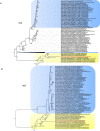Whole genome sequencing of low pathogenicity avian influenza virus (H6N2) detected from a Brazilian teal (Amazonnetta brasiliensis) in Brazil, 2023
- PMID: 38860813
- PMCID: PMC11256858
- DOI: 10.1128/mra.00158-24
Whole genome sequencing of low pathogenicity avian influenza virus (H6N2) detected from a Brazilian teal (Amazonnetta brasiliensis) in Brazil, 2023
Abstract
The whole genome sequence of a low pathogenicity avian influenza virus (H6N2) was sequenced from a Brazilian teal (Amazonetta brasiliensis) in Brazil, 2023. Phylogenetic analysis of the whole genome revealed a distinct genome pertaining to South American LPAIV from 2014 to 2016, indicating extensive circulation among South American wild birds.
Keywords: avian viruses; influenza; phylogenetic analysis; wild birds.
Conflict of interest statement
The authors declare no conflict of interest.
Figures

Similar articles
-
Phylogenetic analysis of low-pathogenicity avian influenza H6N2 viruses from chicken outbreaks (2001-2005) suggest that they are reassortants of historic ostrich low-pathogenicity avian influenza H9N2 and H6N8 viruses.Avian Dis. 2007 Mar;51(1 Suppl):279-84. doi: 10.1637/7551-033106R.1. Avian Dis. 2007. PMID: 17494567
-
Spillover of an endemic avian Influenza H6N2 chicken lineage to ostriches and reassortment with clade 2.3.4.4b H5N1 high pathogenicity viruses in chickens.Vet Res Commun. 2024 Apr;48(2):1233-1237. doi: 10.1007/s11259-023-10258-z. Epub 2023 Nov 15. Vet Res Commun. 2024. PMID: 37966679 Free PMC article.
-
H6N2 reassortant avian influenza virus isolate in wild birds in Jiangxi Province, China.Virus Genes. 2024 Jun;60(3):320-324. doi: 10.1007/s11262-024-02068-5. Epub 2024 May 9. Virus Genes. 2024. PMID: 38722491
-
Genetic Characterization and Pathogenesis of Avian Influenza Virus H7N3 Isolated from Spot-Billed Ducks in South Korea, Early 2019.Viruses. 2021 May 7;13(5):856. doi: 10.3390/v13050856. Viruses. 2021. PMID: 34067187 Free PMC article.
-
Experimental infection with low and high pathogenicity H7N3 Chilean avian influenza viruses in Chiloe wigeon (Anas sibilatrix) and cinnamon teal (Anas cyanoptera).Avian Dis. 2011 Sep;55(3):459-61. doi: 10.1637/9665-012011-Reg.1. Avian Dis. 2011. PMID: 22017047
References
-
- de Araujo J, de Azevedo Júnior SM, Gaidet N, Hurtado RF, Walker D, Thomazelli LM, Ometto T, Seixas MMM, Rodrigues R, Galindo DB, da Silva ACS, Rodrigues AMM, Bomfim LL, Mota MA, Larrazábal ME, Branco JO, Serafini P, Neto IS, Franks J, Webby RJ, Webster RG, Durigon EL. 2014. Avian influenza virus (H11N9) in migratory shorebirds wintering in the Amazon Region, Brazil. PLoS ONE 9:e110141. doi: 10.1371/journal.pone.0110141 - DOI - PMC - PubMed
-
- Mota MA, Lima FS, Oliveira PFN, Guimarães MP. 2013. Ações de vigilância para influenza aviária desenvolvida no Brasil, no período de 2004 e 2007. Arq Bras Med Vet Zootec 65:1265–1273. doi: 10.1590/S0102-09352013000500001 - DOI
-
- Araujo J, Petry MV, Fabrizio T, Walker D, Ometto T, Thomazelli LM, Scherer AL, Serafini PP, Neto IS, Krauss S, Webster RG, Webby RJ, Durigon EL. 2018. Migratory birds in southern Brazil are a source of multiple avian influenza virus subtypes. Influenza Other Respir Viruses 12:220–231. doi: 10.1111/irv.12519 - DOI - PMC - PubMed
Grants and funding
LinkOut - more resources
Full Text Sources

